Introduction
- The Indus Civilisation represents the first phase of urbanisation in India.
- While the civilisation was in its peak, several cultures, namely, Mesolithic and Neolithic cultures prevailed in other parts of India.
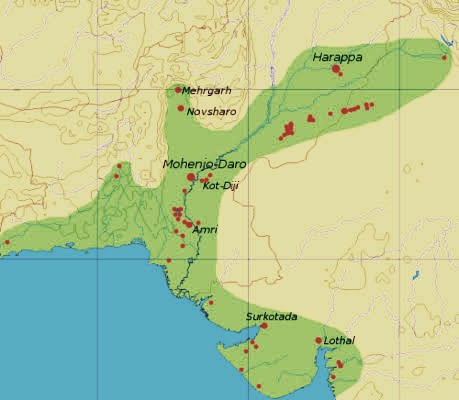
Nomenclature ,Phases and Chronology
- The civilisation that appeared in the north- western part of India and Pakistan in third millennium BCE is collectively called the Indus Civilisation.
- Since Harappa was the first site to be identified in this civilisation, it is also known as Harappan Civilisation.
- This civilisation did not appear all of a sudden. The beginnings of the Neolithic villages in this region go back to about 7000 BCE at the Neolithic site of Mehrgarh.
Harappan Civilization is said to be Urban because of
1.Well conceived town planning.
2.Astonishing Masonry and architecture.
3.Priority for hygiene public Health.
4. Standardised Weights and measures.
5.Solid agricultural and artisanal base.
Unique Feature of Harappan Civilisation :
Town planning is the unique feature of Indus Civilisation.
Harappan City has two planned areas.
- Upper Town.
—-The part of the city to the west was higher and it was called citadel.
—-It was used by the administrators.
—-Great Bath and Graneries are located.
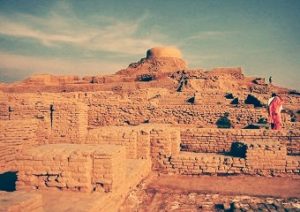
Figure : Upper Town-Citadel
- Lower Town.
—-The part of the city to the east was lower but larger
—-It was inhabited by common people.
Harappan culture is divided into various phases:
—->Early Harappan 3000–2600 BCE
—->Mature Harappan 2600–1900 BCE
—->Late Harappan 1900–1700 BCE
- The urban phase was prevalent in the mature Harappan period and began to decline afterwards.
- The Indus valley site of Harappa was first visited by Charles Mason in 1826, and Amri by Alexander Burnes in 1831.
- The site of Harappa was destroyed for laying the railway line from Lahore to Multan.
- The seal from this site reached Alexander Cunningham, the first surveyor of the Archaeological Survey of India (ASI).
- But the importance of the site and the associated civilisation were not realised until Sir John Marshal took over as the Director General of ASI and initiated research at the site.
- Later in the 1940s, Mortimer Wheeler excavated the Harappan sites.
- Kalibangan, Lothal, Rakhi Garhi and Dholavira are the Indian sites that have been since excavated.
Geographical area and settlements:
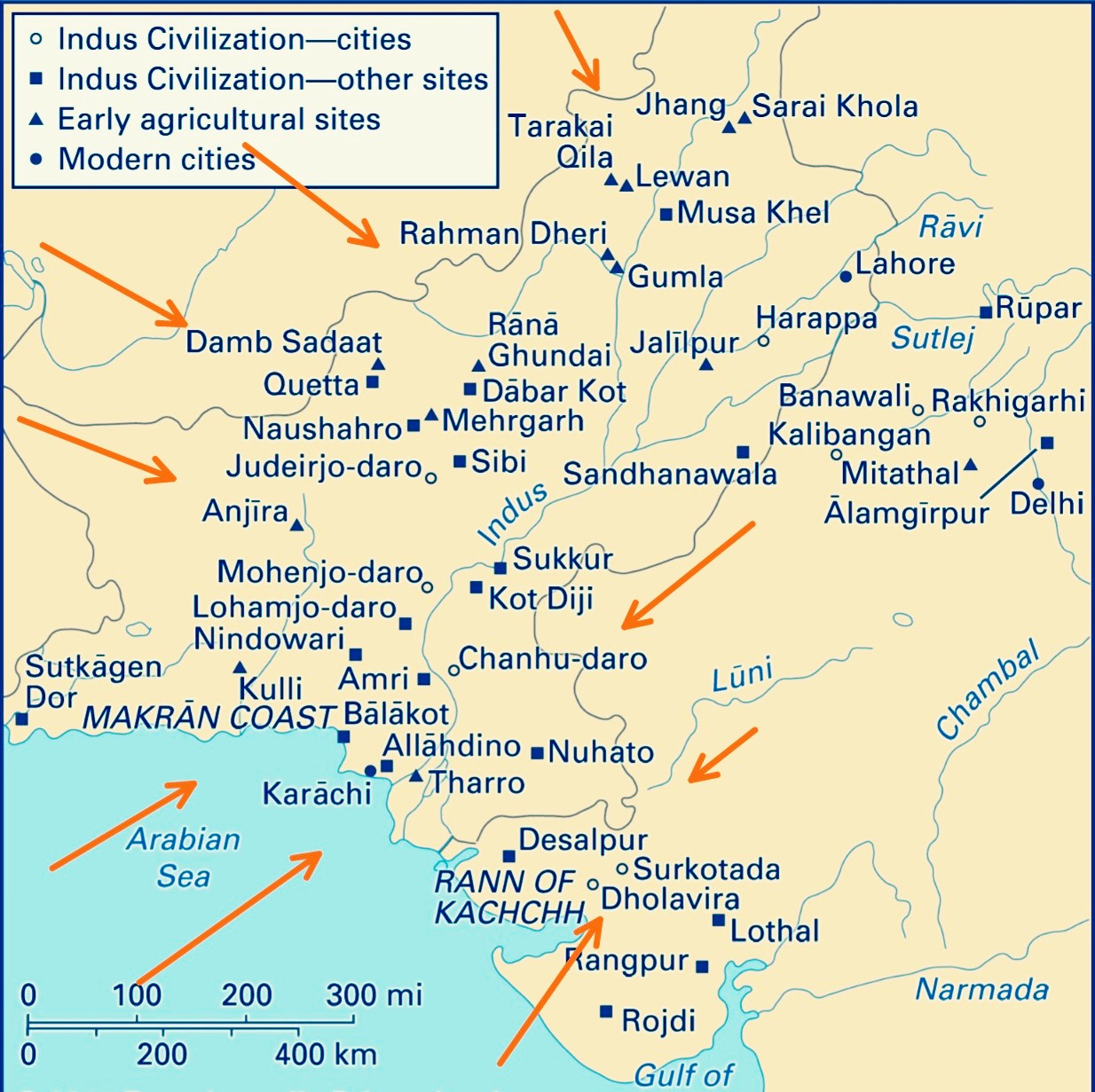
- The Indus Civilisation and the contemporary cultures covered nearly 1.5 million sq. km area in India and Pakistan.
- The settlements of Sutkagen-dor in the west on the Pakistan– Iran border; Shortugai (Afghanistan) in the north; Alamgirpur (Uttar Pradesh, India) in the east and Daimabad (Maharashtra, India) in the south are the boundaries of this civilisation.
- Its core area was in the regions of Pakistan, Gujarat, Rajasthan and Haryana.
- The Indus region (Mehrgarh) is one of the areas of the world where agriculture and animal domestication began very early.
- The early Harappan phase saw the development of villages and towns in the entire region.
- In the Mature Harappan phase, urban centres developed.
Planned Towns:
- Harappa (Punjab, Pakistan), Mohenjo-Daro (Sindh, Pakistan), Dholavira, Lothal, and Surkotada (Gujarat, India), Kalibangan and Banawali (Rajasthan, India), and Rakhigarhi (Haryana, India) are the major cities in the Harappan period.
- Fortification, well- planned streets and lanes and drainages are noticed in the Harappan towns.A civic authority perhaps controlled the planning of the towns.
- The Harappans used baked and unbaked bricks, and stones for construction.The towns had a grid pattern and drainages were systematically built.
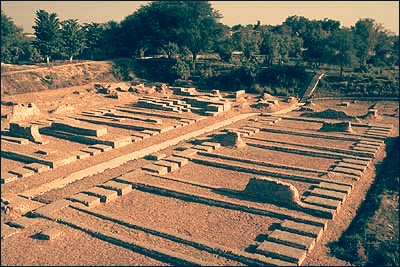
Figure : Granery in Harappa
- The houses were built of mud bricks while the drainages were built with burnt bricks. Houses had more than one floor. The site of Mohenjo-Daro had a planned town, built on a platform.
- It has two distinct areas. One is identified as a citadel and another as the lower town.
- The houses had bathrooms paved with burnt bricks and proper drains. Some houseshad stairs indicating the existence of an upper floor.
- The houses had multiple rooms. Many of the houses had a central courtyard with rooms all around.
- The citadel area had important residential structures that were either used by the public or select residents.In Mohenjo-Daro, a building has been identified as a warehouse. The Great Bath is a tank situated within a courtyard.

Figure : Great Bath
- The corridors were present on all four sides and stairs are seen on the northern and southern sides. It was well paved with several adjacent rooms. Some structures are identified as granary.
- The bricks were laid watertight with gypsum mortar. It had drainage. It is associated with a ritual bath.
Leader In MohenjaDaro

Figure : Priest King
- A sculpture of a seated male has been unearthed in a building, with a head band on the forehead and a smaller ornament on the right upper arm.
- His hair is carefully combed, and beard finely trimmed.
- Two holes beneath the ears suggest that the head ornament might have been attached till the ear.
- The left shoulder is covered with a shawl-like garment decorated with designs of flowers and rings.
- This shawl pattern is used by people even today in those areas.
Streets and Houses
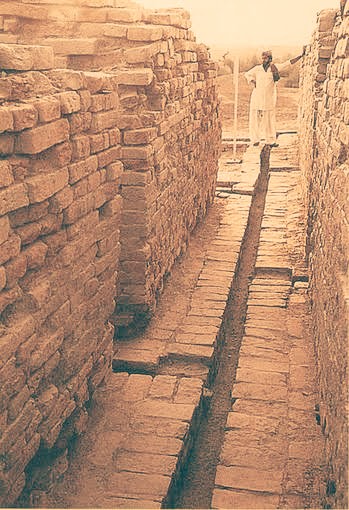
- The streets are observed to have a grid pattern. They were straight running from north to south and east to west and intersected each other at right angles.
- The roads were wide with rounded corners.
- Houses were built on both sides of the street. The houses were either one or two storeys.
- Most of the houses had many rooms, a courtyard and a well. Each house had toilets and bathrooms.
- The houses were built using baked bricks and mortar. Sun-dried bricks were also used. Most of the bricks were of uniform size. Roofs were flat.
- There is no conclusive evidence of the presense of palaces or places of worship.
Drainage System

- Many of these cities had covered drains. The drains were covered with slabs or bricks.
- Each drain had a gentle slope so that water could flow.
- Holes were provided at regular intervals to clear the drains.
- House drains passed below many lanes before finally emptying into the main drains.
- ¾Every house had its own soak pit, which collected all the sediments and allowed only the water to flow into the street drain.
Bronze Age
It is a historical period characterised by the use of articles made of bronze.
Technology
- Indus people had developed a system of standardised weights and measures.
- Ivory scale found in Lothal in Gujarat ¾ is 1704mm (the smallest division ever recorded on a scale of other contemporary civilisations).
Do you know The hidden treasures of the Indus civilisation
Apparel
- Cotton fabrics were in common use.
- Clay spindles unearthed suggest that yarn was spun.
- Wool was also used.
Love and peace
- Settlements were built on giant platforms and elevated grounds.
- The Indus Civilisation seems to have been a peaceful one. Few weapons were found and there is no evidence of an army.
- They displayed their status with garments and precious jewellery.
- They had an advanced civic sense.
Ornaments
- Ornaments were popular among men and women.
- They adorned themselves with necklaces, armlets, bangles, finger rings, ear studs and anklets.
- The ornaments were made of gold, silver, ivory, shell, copper, terracotta and precious stones.
- Iron was unknown to people of Indus.
- Indus people used the red quartz stone called Carnelian to design jewellery.
Info Bits
- Copper was the first metal discovered and used by humans
Economy of Indus Valley Civilisation
- Agriculture was an important source of subsistence for the Harappans.
- The Harappans cultivated diverse crops such as wheat, barley, lentil, chickpea, sesame and various millets.
- Agricultural surplus was an important stimulus for a number of developments.
- They adopted a double cropping system. The Harappans used ploughs.
- They perhaps ploughed the land and then sowed the seeds. Ploughed fields have been found at Kalibangan. They used both canal and well irrigation.
Fact :
- Archaeobotanists study ancient agriculture, and human and environmental relationships.
- A granary with walls made of mudbricks, which are still in a good condition, has been discovered in Rakhigarhi, a village in Haryana, belonging to Mature Harappan Phase.
Animal Domestication

- Pastoralism was also practised by the Harappans. They domesticated sheep, goat and fowl.
- They had knowledge of various other animals including buffalo, pig and elephant. But horse was not known to them.
- The Harappan cattle are called Zebu. It is a large breed, often represented in their seals.They also ate fish and birds.
- Evidence of boar, deer and gharial has been found at the Harappan sites.

Craft Production
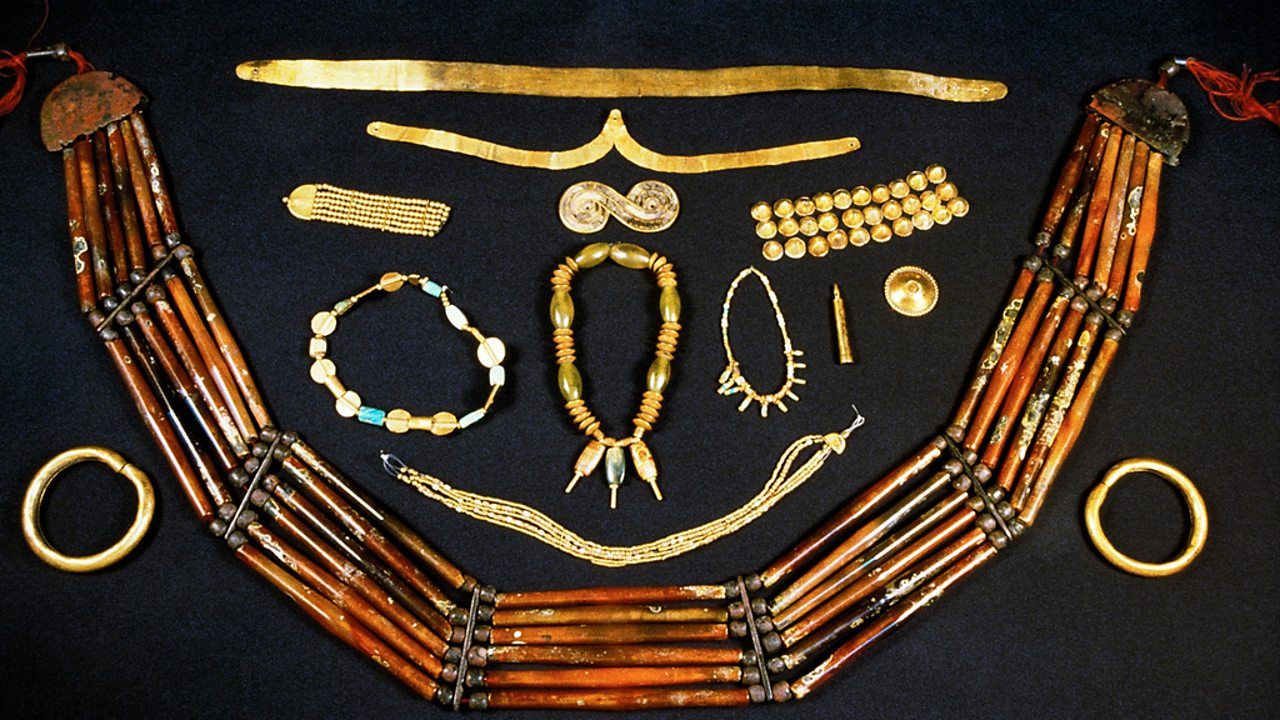
- Craft production was an important part of the Harappan economy. Bead and ornament making, shell bangle making and metalworking were the major crafts.
- They made beads and ornaments out of carnelian, jasper, crystal, and steatite, metals like copper, bronze and gold and shell, faience and terracotta or burnt clay.
- The beads were made in innumerable designs and decorations. They were exported to Mesopotamia and the evidence for such exported artefacts have been found from the excavations in Mesopotamian sites.

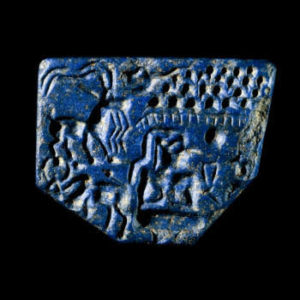 <—Figure : Lapis Lazuli
<—Figure : Lapis Lazuli
Material Site or Source
- Shell Nageshwar and Balakot
- Lapis lazuli Shortughai
- Carnelian Lothal
- Steatite South Rajasthan
- Copper Rajasthan and Oman.
Pottery

- The Harappans used diverse varieties of pottery for daily use. They use well-fired pottery.
- Their potteries have a deep red slip and black paintings. The pottery are shaped like dish-on-stands, storage jars, perforated jars, goblets, S-shaped jars, plates, dishes, bowls and pots.
- The painted motifs, generally noticed on the pottery, are pipal leaves, fish-scale design, intersecting circles, zigzag lines, horizontal bands and geometrical motifs with floral and faunal patterns.
- The Harappan pottery is well- baked and fine in decorations.
Metals,Tools and Weapons
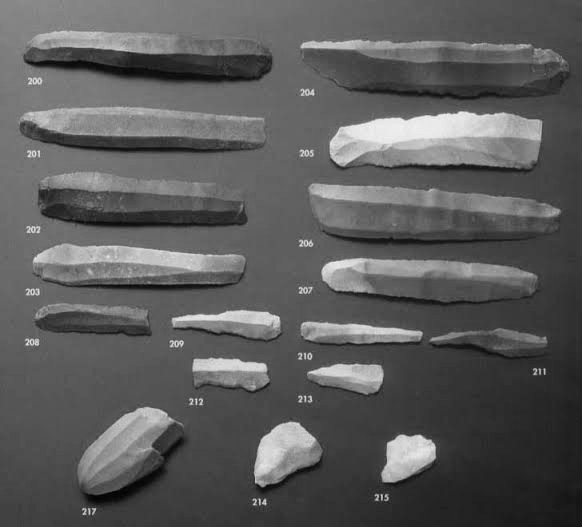
- The Harappan civilisation belongs to the Bronze Age civilisation and Harappans knew how to make copper bronze tools.
- Although they produced bronze implements, they needed various kinds of tools for agriculture and craft production.
- The Harappans used chert blades, copper objects, and bone and ivory tools.
- The tools of points, chisels, needles, fishhooks, razors, weighing pans, mirror and antimony rods were made of copper.
- The chert blade made out of Rohrichert was used by the Harappans.
- Their weapons include arrowheads, spearhead, celt and axe.
- They did not have the knowledge of iron.
Fact
Rohri chert
The chert, a fine grained sedimentary rock, was found in the region of Rohri in Pakistan. It was used by the Harappans for making stone blades and tools.
Dockyards at lothal.
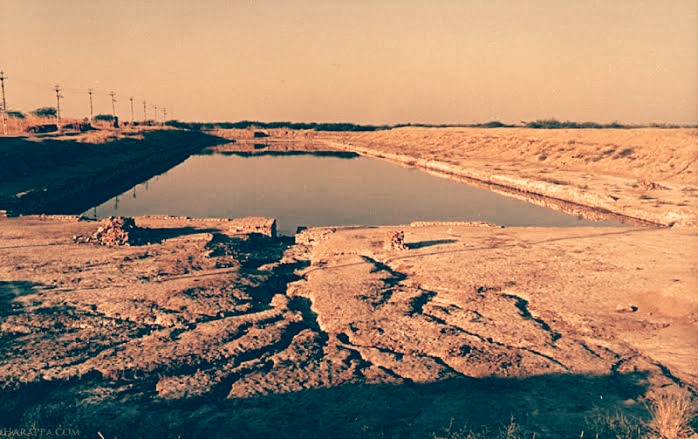
A naval dockyard has been disvovered in lothal in Gujarath.It shows the maritime activities of the Indus people.
Lothal is situated on the banks of a tributary of sabarmati river in Gujarat.
Textiles and Ornaments ;
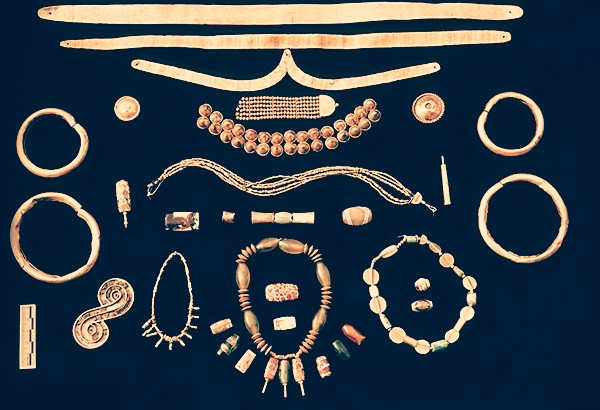
- The Harappans wore clothes and used metal and stone ornaments. They had knowledge of cotton and silk.
- The image identified as a priest is depicted wearing a shawl-like cloth with flower decorations.
- The terracotta images of women are shown wearing different types of ornaments.
- The image of dancing girl found at Mohenjo- Daro is shown wearing bangles in largenumbers up to the upper arm.
- They made carnelian, copper and gold ornaments. Some of them had etched designs and they exported them to the Mesopotamian world.
- Faience, stoneware and shell bangles were also used.
- The ornaments produced were either sold or exchanged as part of the trade activities.
Trade and Exchange
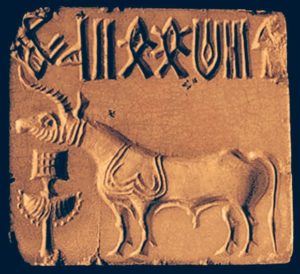
- One of the sources of Harappan economy was trade and exchange activities.
- Harappans had close trade contacts with the Mesopotamians and also with various cultures of India.
- The Harappan seals and materials have been found in the Sumerian sites in Oman, Bahrain, and Iraq and Iran.
- The cuneiform inscriptions mention the trade contacts between Mesopotamia and Harappans.
- The mention of “Meluhha” in the cuneiform inscriptions refers to the Indus region.
- A Harappan jar has been found in Oman.Harappan seals, weights, dice and beads are found in Mesopotamia.
- Carnelian, lapis lazuli, copper, gold and varieties of wood were exported to Mesopotamia.
- Indus seals have been found in Mesopotamia which are modern day iraq,kuwait and parts of syria.This shows their extensive trade with Mesopotamis. King Naram Sin of Akkadian Empire ( Sumerian) has written about buying jewellery from the land of Melukha (a region of the indus valley) .
Cylindrical seals similar to those found in. persian Gulf and mesopotamia have also been found in the indus area.
Weights and Measures

- Harappans had developed proper weights and measures.
- Since they were involved in commercial transactions, they needed standard measures.
- Cubical chert weights have been unearthed from Harappan sites.
- The weights exhibit a binary system. The ratio of weight is doubled as 1:2:4:8:16:32.
- The small weight measure of 16th ratio weighs 13.63 grams. They also used a measuring scale in which one inch was around 1.75 cm.
- Weights made of chert were cubical. They used binary numbering system (1, 2, 4, 8, 16, 32, etc.). They might have been used for weighing jewellery and metal.
Seals ,Sealings and Scripts
- The seals from various media such as steatite, copper, terracotta and ivory arefrequently found in the Harappan sites.
- The Harappan script has not yet been convincingly deciphered. About 5,000texts have been documented from the Harappan sites. The longest text has about twenty six signs.
- Some scholars are of the view that it is Dravidian. Seals might have been used as an identity marker on the materials that were transported. They might have indicated the ownership.
Arts and Amusements ;
- The terracotta figurines, the paintings on the pottery, and the bronze images from the Harappan sites suggest the artistic nature of the Harappans.
- “Priest king” of steatite, dancing girl of copper and stone sculptures from Harappa, Mohenjo-Daro and Dholavira are the important objects of art.
- Toy carts, rattles, wheels, tops, marbles and hop scotches exhibit the amusement of the Harappan people.
Faith and Belief System
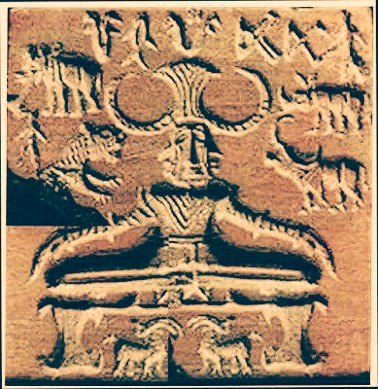
- The Indus people worshipped nature. They worshipped the pipal tree.
- Some of the terracotta figures appear to be mother goddess.
- Fire altars have been identified at Kalibangan.
- They buried the dead. Burials were made elaborately and evidence of cremation is also reported.
- The Harappan burials have pottery, ornaments, jewellery, copper mirrors and beads. These suggest their belief in an afterlife.
Polity
- Uniformity in pottery, seals, weights and bricks reveals the existence of a polity.
- Labour mobilisation may also suggest the existence of a political system.
- Harappa and Mohenjo-Daro might have had a city- state like polity.
- The uniformity in the cultural materials and measurement units point to a central authority during the Harappan times.
Authorship
- One school of thought argues that the authors of Harappan Civilisation were speakers of Dravidian Languages.
- Archaeological evidence shows movement of the Harappans to the east and the south after the decline of their civilisation.
- Some of the Harappan people could have move into different parts of India. However, only the decipherment of the script would give us a definite answer.
- Contemporary Culture of Indus Valley Civilisation.
- Several groups including pastoral people, farmers and hunter-gatherers lived in the Indus region. The Indus region had villages and large towns.
- The population of that time was mixed. Innumerable communities of hunters-gatherers, pastoral people and farmers, from Kanyakumari to Kashmir and Gujarat to Arunachal Pradesh could have existed during this period.
- Their history is also equally important, as cultural and ecological knowledge of all these groups contributed to Indian culture.
- While the Indus Civilisation was flourishing in the north-western part of India, several cultures were developing in different parts of India.
- In the southern part of the subcontinent, Kerala and Sri Lanka were given to hunting and gathering.
- The Harappans who had knowledge of water crafts might have had connections andinteractions with South India, but no cleaarchaeological evidence on this is available.
- The northern part of South India, i.e. the Karnataka and Andhra region, had Neolithic cultures, engaged in pastoralism and plough agriculture.
- Similarly, the Chalcolithic cultures were prevalent in Deccan and western India, while Neolithic cultures permeated northern India including Kashmir, Ganges valley and central and eastern India. Thus India was a cultural mosaic during the time of the Harappans.
Decline
- The Indus Valley Civilisation declined from about 1900 BCE.
- Changes in climate, decline of the trade with the Mesopotamia, and the drying of the river and water resources due to continuous drought are some of the reasons attributed by historians for the decline. Invasions, floods and shifting of the river course are also cited as reasons for the ruin of Indus civilisation.
- In course of time, the people shifted to the southern and eastern directions from the Indus region.’
Indus Civilisation and Tamil Civilisation
- The Indus Civilisation represents the first urbanisation of Indian history. The origin and authorship of the Indus Civilisation are keenly debated historical questions.
- The Indus script has not yet been conclusively deciphered and hence the authorship is not certain.
- The graffiti found on the megalithic burial pots of South India and the place names presented arecited to establish the relationship between Indus and Tamil cultures.
- The archaeological evidence points to several groups of people living in Tamil Nadu and South India continuously from the Mesolithic period.
- One cannot rule out the migration of a few groups from the Indus region. More research is necessary before arriving at any definite conclusion.
- The towns of ancient Tamizhagam such as Arikamedu, Keezhadi and Uraiyur thatflourished are part of the second urbanisation of India and these towns are quite different from the Indus cities.
